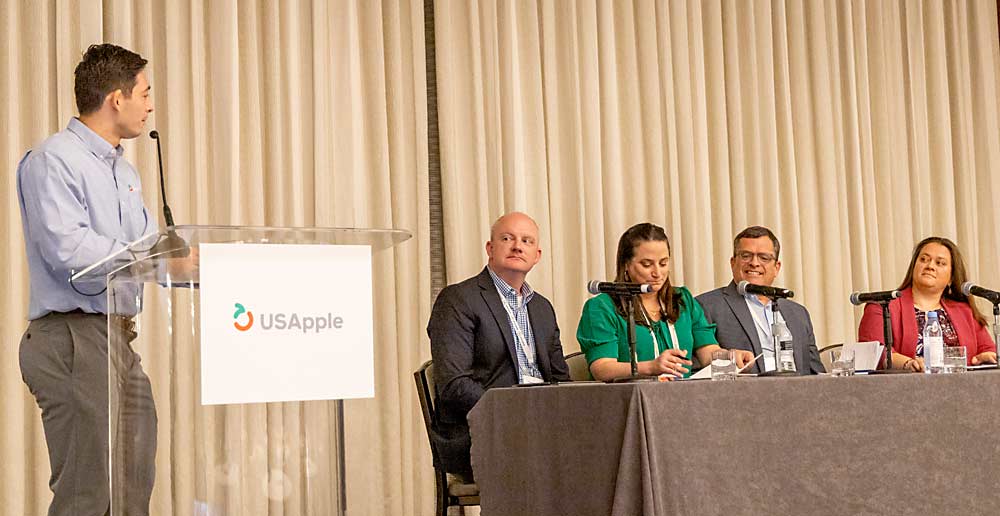
The U.S. Apple Association organized panels of speakers to discuss food safety and sustainability during its annual Outlook conference in August.
The food safety panel focused on product recall insurance. If listeria, salmonella or other pathogenic bacteria are found on apples in the supply chain, it would spark a recall. That means cascading consequences for more than just the source.

“You have a problem in a potential recall, even if it wasn’t your fruit,” said Steve Clement, CEO of Sage Fruit Co., a Yakima, Washington, fruit marketer. “If multiple shippers supply a retailer with product, it may not be known whose fruit it was, and you could get caught up in the recall even if your fruit was clean.”
The risk of “guilt by association” is real, according to the panelists. No matter how good your food safety practices, your apples are out of your hands at many points in the supply chain, and they are often mixed with apples from other sources.
Apple recalls are rare but not unprecedented. In 2014, a listeriosis outbreak tied to caramel apples led to several deaths and dozens of hospitalizations, and in 2019, a Michigan warehouse conducted a voluntary recall of more than 2,000 cases due to possible listeria contamination, although no illnesses were reported.
Investigators can trace food safety outbreaks back to the warehouse level, but even though traceability efforts continue to improve, it’s more difficult to pinpoint specific growers at this point, said panelist Kyle Womach, an agribusiness risk advisor at PayneWest Insurance.

And even if they can pinpoint the source of the pathogen, by then it might be too late: Once apples have been recalled, your reputation, and that of the industry, has taken a hit. It’s important to be prepared for that worst-case scenario, so you can cover your costs and begin to rebuild your brand’s reputation. Product recall insurance, which refunds the value of the recalled product or covers the cost of disposal, can be a critical tool in that process — but not a cheap one.
Womach said insurance rates in general are increasing, while legal settlements are becoming more expensive.
Brandon Sielen, senior vice president at insurance broker Marsh, said the product recall insurance market is growing, with major insurers looking to diversify their portfolios.
Despite the costs, product recall insurance coverage is an important part of Sage Fruit’s risk management strategy. Clement said coverage would help the company pay its suppliers in the event of a recall and provide money for legal assistance, public relations work and reputation management. It also provides access to organizations that perform mock recalls and examine recall policies.
“One thing common among all apple growers is they want to get paid, whether there’s a recall or not,” Clement said. “It’s definitely worth it to make sure we protect the people who are supplying us.”
Preparing for a food safety recall before it happens is crucial. This would include developing standard operating procedures and conducting mock recalls, Womach said.
Clement recommended preparing draft recall letters for retailers and customers. Get to know the public relations companies, law firms and industry associations you’ll be working with. “Have their numbers handy, because you can get underwater pretty quick,” he said.
“Nothing eliminates fear like having a plan,” Clement said. “Knowing that you have your ducks in a row for a product recall scenario is an integral part of the process.”
Sustainability
USApple’s second panel focused on a more nebulous concept: sustainability.
“Sustainability” means different things to different people, but the USApple panelists loosely defined it as maintaining the ability to grow fruit today, tomorrow, a decade — even a century — from now.
“Sustainability is at the core of what we do,” said Amy Tranzillo, global head of marketing for AgroFresh. “Everything we do in terms of postharvest technology really guides us toward how we can reduce food loss and waste, and make production more efficient so the highest-quality produce actually comes out the other end.”
Jamie Kober, enhancement director at Riveridge Produce Marketing in Sparta, Michigan, said his company’s sustainability initiatives include organic certification, pollinator habitats, more efficient pesticide applications and labor-saving technologies.
“Sustainability is also good business,” he said.
In the Pacific Northwest, water conservation has been a major sustainability focus for decades. In order to preserve that resource, the industry maintains reservoirs and canals, negotiates water rights and adopts water-saving technologies such as specialized spray nozzles and shade cloth, said Mike Preacher, vice president of marketing for Domex Superfresh Growers in Yakima, Washington.
Even in Michigan, where there’s a lot of fresh water, growers need more efficient ways to utilize it, Kober said.
“We’re lucky in Michigan, but just because we’re surrounded by water doesn’t mean it’s always where we want it,” he said.
To get the sustainability message across, growers must identify their relevant practices and communicate them to consumers. Growers are doing the right things in general, but they need to be more vocal, Kober said.
“You’ve already started, and you probably don’t know it,” Kober told the USApple audience. “Identify what you’re doing and start to take credit.”
Tranzillo agreed.
“If you can’t measure it, you can’t celebrate it,” she said. “I think many people in this room, and in the industry in general, do wonderful things for the environment but haven’t been able to measure it.”
If consumers understood growers’ passion for their jobs, land and lifestyle, they would better understand their commitment to sustainability, said Lex Roberts, director of culture and compliance at Rice Fruit Co. in Gardners, Pennsylvania.
“Their land has been in the family for generations, and they want to keep it in the family,” Roberts said. “How do we tell that story?”
To get the word out, Tranzillo recommended utilizing the resources of industry organizations, which are always willing to collaborate on sustainability messaging.
“We have to think about how we will be communicating,” she said. “Who is the audience? How do we get them to buy high-value apples? That’s really the crux of any marketing campaign.”
—by Matt Milkovich







Leave A Comment